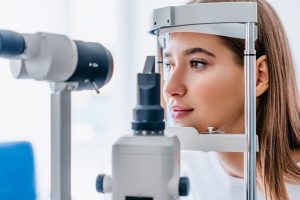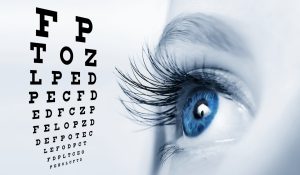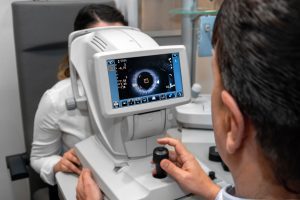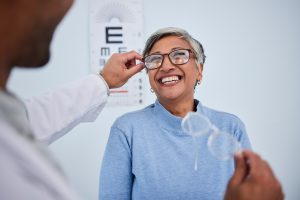Dry Eyes
HOW DO YOU FIX DRY EYES?
Dry eyes can be a very uncomfortable and inconvenient condition, but fortunately, there are several methods for treating them. The most important thing to remember with dry eyes is that it is important to treat the underlying cause of eye dryness. Dry eyes are commonly a symptom of another problem. This could be due to a variety of reasons, such as environmental conditions, underlying health conditions, allergies, medications, or even age-related changes.
It’s important to go to your eye doctor to diagnose and treat the underlying cause. At Louie Eyecare Centre, we offer comprehensive eye exams to ensure that the underlying cause of your dry eyes is properly identified and treated.
HOW DO YOU TREAT DRY EYES?
Treating dry eyes can be done in a variety of ways. For mild cases, over-the-counter eye drops can provide relief from the symptoms. These products contain components that mimic natural tears and help to lubricate and soothe dry eyes. There are also ways to increase the amount of oil released from the eyelids to keep the natural tear on the eye longer. In more severe cases, prescription medications such as cyclosporine (Restasis), lifitegrast (Xiidra), or steroid eye drops may be necessary. If an underlying health condition causes dry eyes, it is important to treat the underlying cause in order to get long-term relief.
For those who use computers for long periods of time, taking regular breaks from the screen can also help prevent eye strain and reduce the risk of developing dry eyes. Dr. Larson and Dr. Louie like to recommend the 20/20/20 rule – Every 20 minutes, take 20 blinks, and look at least 20 feet in the distance to relax your near focus and refresh your tear film. Additionally, wearing sunglasses when outdoors can protect your eyes from the wind and sun, which can worsen dry eye symptoms. In addition, using a humidifier can help to add moisture to the air and reduce the dryness associated with indoor air conditioning. Finally, staying hydrated by drinking plenty of fluids throughout the day is important for maintaining healthy eyes. A combination of these strategies can help to reduce the severity and frequency of dry eye symptoms. Taking care of your eyes is essential for optimal vision and overall health.
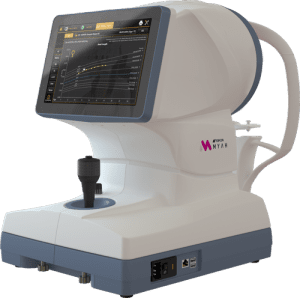
Now Featuring MYAH For Dry Eyes
MYAH is a state-of-the-art medical instrument newly available at Louie Eyecare Centre, specifically designed to support optometrists in the treatment and management of eye conditions such as myopia and dry eyes. This advanced tool enables early detection and effective monitoring, providing a comprehensive understanding of eye health that prioritizes patient well-being. If you or a loved one is experiencing dry eye or other eye-related concerns, book an eye exam with Louie Eyecare Centre to benefit from the cutting-edge capabilities of MYAH.
West Edmonton Vision Clinic
Visit our vision clinic in central West Edmonton for comprehensive eye exams, contact lens fittings, glasses, and more. Louie Eyecare Centre is dedicated to providing the highest quality optometric services and products to our patients. Our team of experienced optometrists is here to help you with all of your eye care needs. Schedule an appointment today!
Clinic Hours
Monday Closed
Tuesday 9:00-5:00
Wednesday 9:00-5:00
Thursday 9:00-5:00
Friday 9:00-5:00
Saturday 9:00-2:00
Closed Sunday / Holidays
OUR CLIENTS' FEEDBACK
Frequently Asked Questions
Wearing glasses or contacts can indeed affect dry eye symptoms, but the impact varies. Glasses can help shield the eyes from environmental factors that exacerbate dry eye, such as wind or air conditioning. On the other hand, contact lenses can sometimes worsen dry eye symptoms by absorbing tear moisture or by causing irritation. Certain types of contact lenses are designed to be more breathable and retain moisture better, which may be suitable for people with dry eyes. It’s crucial to discuss with an eye care professional to find the most appropriate type of contact lens or glasses. Proper care and hygiene when using contacts, along with regular breaks from screen use, can help minimize dry eye symptoms.
Dry eye syndrome can be both a temporary condition and a chronic disease, depending on its cause and severity. Environmental factors or certain life situations, such as screen use or air travel can cause temporary dry eye. Chronic dry eye, on the other hand, may result from systemic diseases, medication side effects, or age-related changes in tear production. Management and treatment can alleviate symptoms, but chronic dry eye often requires ongoing therapy. It’s important to consult with an eye care professional for an accurate diagnosis and treatment plan. Understanding the underlying cause is key to determining whether dry eye syndrome will be a temporary issue or a chronic condition.
Yes, some specific exercises and therapies can help relieve dry eye symptoms. Blinking exercises, for example, can help improve meibomian gland function and tear film stability. Warm compresses applied to the eyes can also stimulate tear production and release oils from the glands in the eyelids. Gentle eyelid massages can help spread the oils evenly across the eye surface, reducing dryness. Using a humidifier to add moisture to the air and taking regular breaks to rest the eyes during screen time can also be beneficial. Newer technologies such as IPL (Intense Pulsed Light) and RF (Radio Frequency) are also becoming available. Consulting with an eye care professional for personalized advice on exercises and therapies is recommended.
Sleep plays a crucial role in managing dry eye syndrome. Poor sleep can lead to insufficient eye lubrication and worsening dry eye symptoms. During sleep, the eyes rejuvenate and produce the moisture needed for the next day. Good sleep hygiene practices can help ensure the eyes are well-rested and hydrated. It’s also important to avoid sleeping with any airflow directly hitting the face, as this can dry out the eyes. Establishing a regular, restful sleep schedule can significantly improve dry eye symptoms.
Indeed, some medications can exacerbate dry eye symptoms. Diuretics, antihistamines, antidepressants, and some blood pressure medications are known to reduce tear production or alter tear composition. It’s important to review any current medications with a healthcare provider to determine if they could be contributing to dry eye symptoms. Sometimes, alternative medications with fewer dry eye side effects can be prescribed. Always consult with a healthcare professional before making changes to medication regimens. Patients should also stay hydrated and consider using artificial tears if taking medications known to cause dryness.
Yes, it is quite common for dry eye symptoms to worsen in certain weather conditions. Dry, windy, or smoky environments can lead to increased tear evaporation, exacerbating symptoms. Conversely, high humidity can sometimes alleviate dry eye symptoms because the air is more saturated with moisture. Cold weather, especially during winter when indoor heaters are used, can also dry out the eyes. It’s advisable to use humidifiers in such conditions to maintain indoor humidity levels. Wearing wraparound glasses or protective eyewear outdoors can help shield eyes from harsh conditions.
